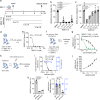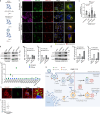PIP4K2C inhibition reverses autophagic flux impairment induced by SARS-CoV-2
- PMID: 40640184
- PMCID: PMC12246422
- DOI: 10.1038/s41467-025-61759-1
PIP4K2C inhibition reverses autophagic flux impairment induced by SARS-CoV-2
Abstract
In search for broad-spectrum antivirals, we discover a small molecule inhibitor, RMC-113, that potently suppresses the replication of multiple RNA viruses including SARS-CoV-2 in human lung organoids. We demonstrate selective inhibition of the lipid kinases PIP4K2C and PIKfyve by RMC-113 and target engagement by its clickable analog. Lipidomics analysis reveals alteration of SARS-CoV-2-induced phosphoinositide signature by RMC-113 and links its antiviral effect with functional PIP4K2C and PIKfyve inhibition. We identify PIP4K2C's roles in SARS-CoV-2 entry, RNA replication, and assembly/egress, validating it as a druggable antiviral target. Integrating proteomics, single-cell transcriptomics, and functional assays, reveals that PIP4K2C binds SARS-CoV-2 nonstructural protein 6 and regulates virus-induced autophagic flux impairment. Promoting viral protein degradation by reversing autophagic flux impairment is a mechanism of antiviral action of RMC-113. These findings reveal virus-induced autophagy regulation via PIP4K2C, an understudied kinase, and propose dual PIP4K2C and PIKfyve inhibition as a candidate strategy to combat emerging viruses.
© 2025. The Author(s).
Conflict of interest statement
Competing interests: The authors declare no competing interests.
Figures






Update of
-
PIP4K2C inhibition reverses autophagic flux impairment induced by SARS-CoV-2.bioRxiv [Preprint]. 2024 Apr 17:2024.04.15.589676. doi: 10.1101/2024.04.15.589676. bioRxiv. 2024. Update in: Nat Commun. 2025 Jul 10;16(1):6397. doi: 10.1038/s41467-025-61759-1. PMID: 38659941 Free PMC article. Updated. Preprint.
References
-
- Weaver, S. C., Ferro, C., Barrera, R., Boshell, J. & Navarro, J.-C. Venezuelan equine encephalitis. Annu. Rev. Entomol.49, 141–174 (2004). - PubMed
-
- Sbrissa, D., Ikonomov, O. C. & Shisheva, A. PIKfyve, a mammalian ortholog of yeast Fab1p lipid kinase, synthesizes 5-phosphoinositides: effect of insulin. J. Biol. Chem.274, 21589–21597 (1999). - PubMed
MeSH terms
Substances
Grants and funding
LinkOut - more resources
Full Text Sources
Miscellaneous

